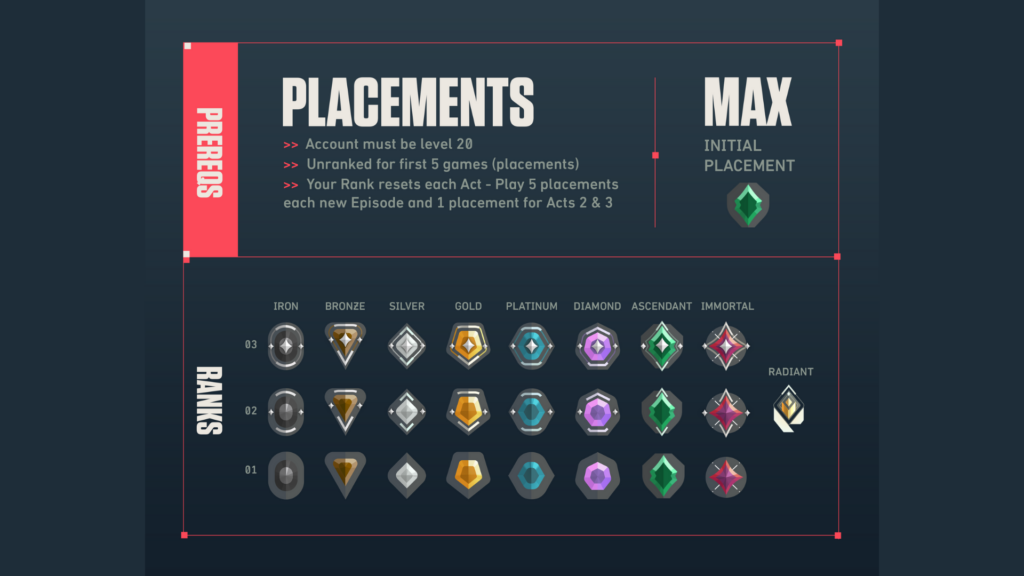VALORANT’s ranked system can be challenging to navigate, but understanding its intricacies is key to climbing the ranks and achieving your competitive goals. This guide covers everything from rank distribution to earning and maintaining your rank.
Looking to buy a VALORANT account? Visit Playswap for a legitimate marketplace.
What Are VALORANT Ranks?
VALORANT ranks measure your skill and progress in the game. Each player has an overall VALORANT rank and an Act rank for each act. Additionally, your rank rating (RR), which is connected to your matchmaking rating (MMR), plays a crucial role in determining your rank.
All VALORANT Ranks in Order:
Here is the complete list of VALORANT ranks:
- Iron 1
- Iron 2
- Iron 3
- Bronze 1
- Bronze 2
- Bronze 3
- Silver 1
- Silver 2
- Silver 3
- Gold 1
- Gold 2
- Gold 3
- Platinum 1
- Platinum 2
- Platinum 3
- Diamond 1
- Diamond 2
- Diamond 3
- Ascendant 1
- Ascendant 2
- Ascendant 3
- Immortal 1
- Immortal 2
- Immortal 3
- Radiant
VALORANT Act Rank:
Your Act rank reflects your highest-ranked win during each act, which Riot refers to as your “proven skill.” This is displayed as a badge filled with colored triangles representing different ranks. The highest-ranked win determines your Act rank and the rewards you receive at the end of the Act. Although your Act rank resets between Acts, your previous MMR influences your placement matches for the next Act.
VALORANT Rank Distribution 2024:
Rank distribution is crucial for understanding the competitive landscape. As of April 2024, here’s the rank distribution according to EsportsTales.com:
- Iron: 7.5%
- Bronze: 17.5%
- Silver: 22.5%
- Gold: 22.2%
- Platinum: 15.7%
- Diamond: 9.6%
- Ascendant: 4%
- Immortal: 0.8%
- Radiant: 0.03%
This distribution shows a significant concentration of players in the mid-ranks (Silver and Gold), with fewer players reaching the higher tiers (Ascendant, Immortal, Radiant).
VALORANT Rank Placements and Restrictions:
To play in VALORANT’s competitive mode, your account must be at least level 20. At the start of each episode, you need to complete five placement matches to determine your rank. For Acts 2 and 3 within an episode, only one placement match is required.
When playing with friends, there are specific rules regarding rank disparity:
- Groups of four are not allowed to prevent solo players from being overwhelmed.
- Groups of two or three must adhere to rank disparity rules.
- Groups of five have no rank disparity restrictions but may face rank rating penalties depending on the ranks involved.
Rank Disparity Rules
- If the lowest rank is Iron or Bronze, the highest rank in the group can be Silver.
- If the lowest rank is Silver, the highest rank can be Gold.
- If the lowest rank is Gold, the highest rank can be Platinum.
- If the lowest rank is Platinum, Ascendant, Immortal, or Radiant, the highest rank can only be one level higher.
Five-stack parties ignore disparity restrictions but may experience significant rank rating penalties if the rank differences are large.
Understanding the VALORANT ranking system is essential for improving your competitive play. Whether you’re aiming to climb out of Silver or reach Radiant, knowing how ranks, Act ranks, and rank ratings work will help you on your journey. For more VALORANT guides, check out our VALORANT tier list, crosshair codes guide, and Night Market overview. If you’re new to the game, learn how to create a VALORANT account here.




More Stories
Exploring the Ideal Pack Headliners in MLB The Show
Understanding The Benefits of Cloud Faxes in Modern Workplaces
5 Reasons Many People Prefer Online Poker Versus In-Person Poker